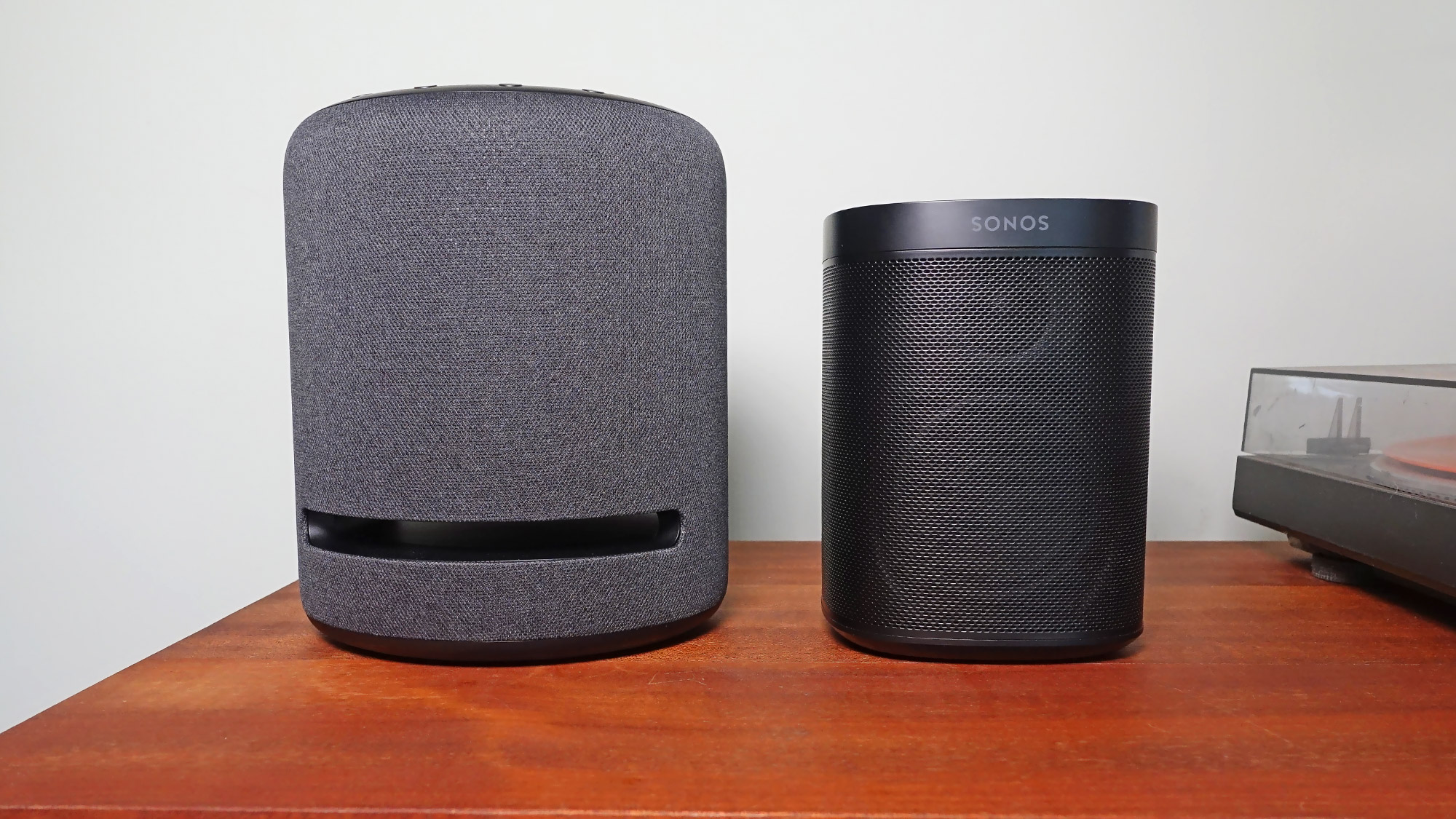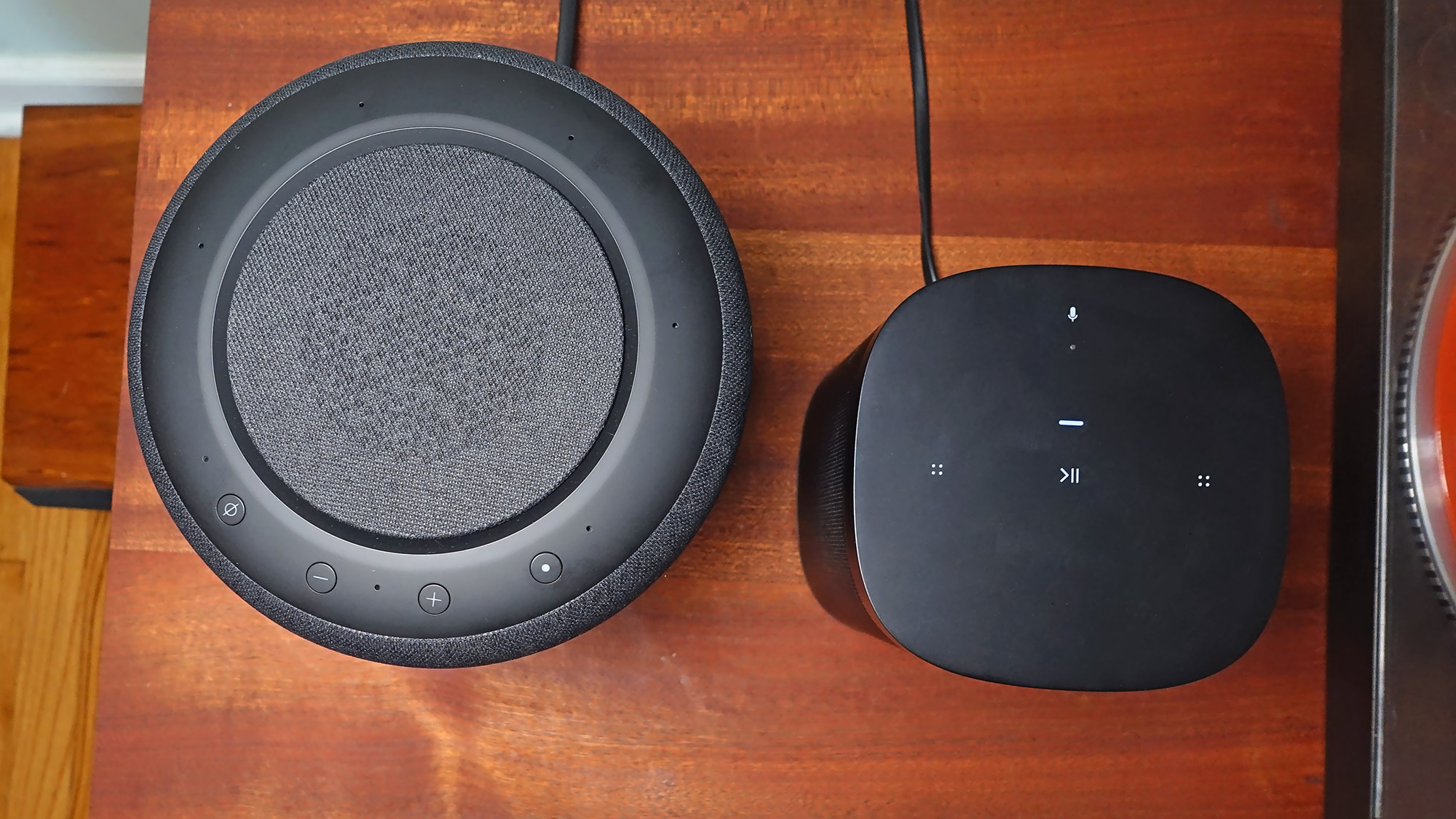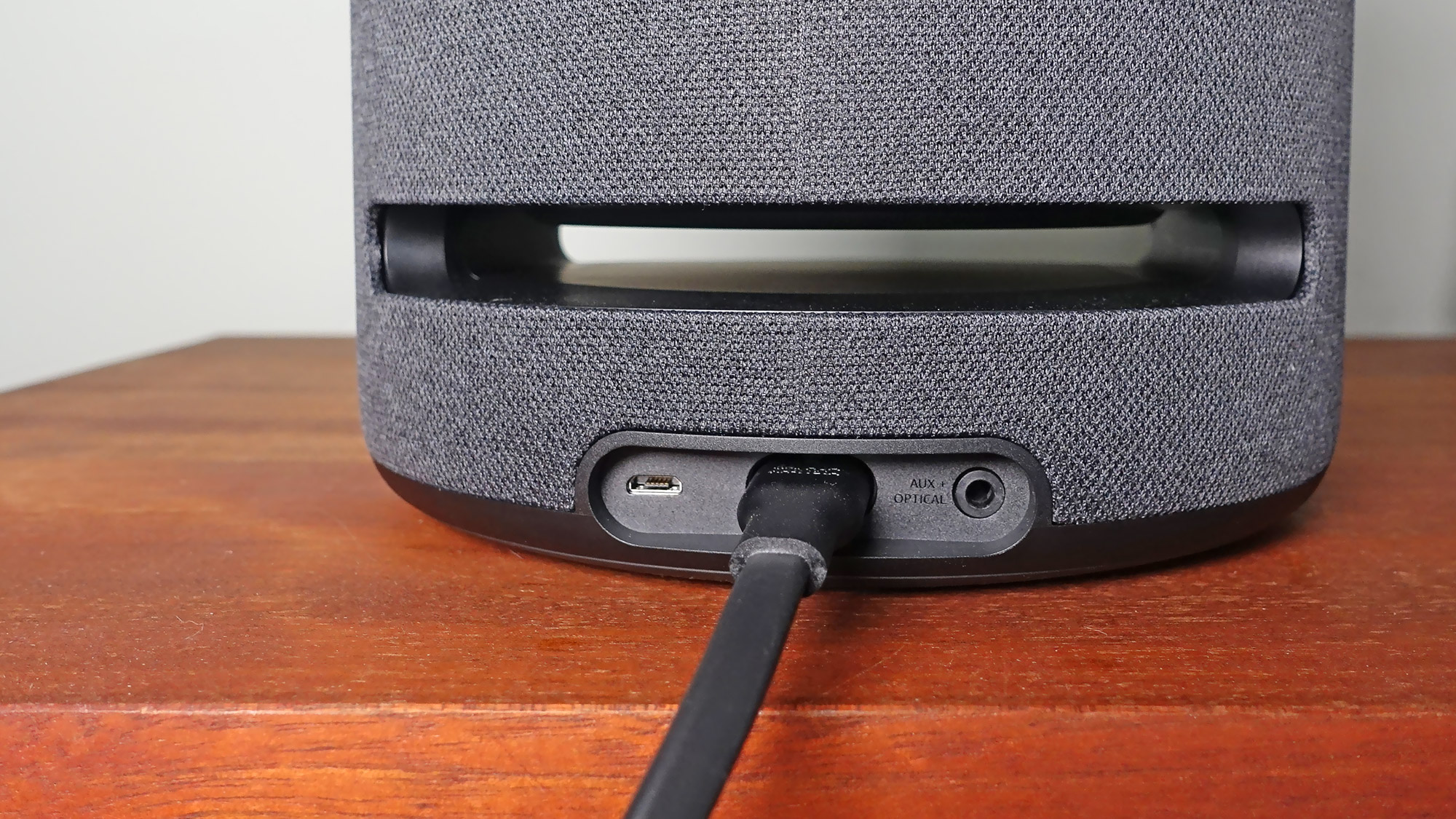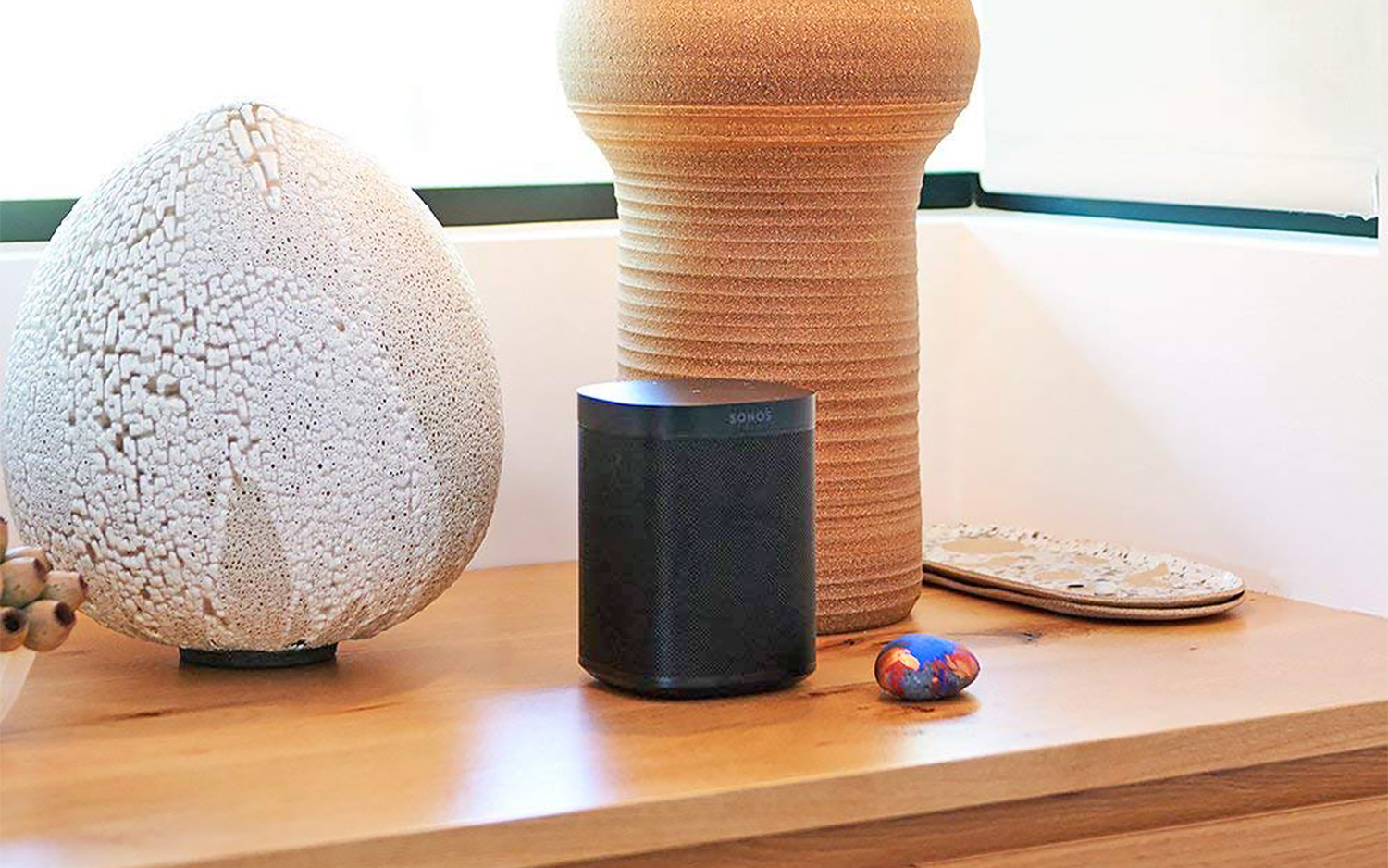Amazon Echo Studio vs. Sonos One: Which Smart Speaker Wins?

Amazon recently announced its first high-end smart speaker, the $199 Amazon Echo Studio. Packed with Alexa, multiple drivers and capable of delivering 360-degree audio, it looks to challenge the Sonos One as the best-sounding smart speaker. But sound is just one aspect of what makes a smart speaker great; let's see how these two compare.
Price
Both the Amazon Echo Studio and the Sonos One cost $199. However, you can still purchase a first-generation Sonos One for about $169; it has an older processor, but otherwise sounds the same as the second-generation Sonos One.
Winner: Tie
Design

While the Echo Studio's design is a natural progression from the smaller and cheaper Amazon Echo, you can't help but draw comparisons between the Studio and the Apple HomePod. The Studio is a broad cylinder wrapped in acoustic fabric. A ring of LEDs around the top lets you know when Alexa is listening, and four small physical buttons let you adjust the volume, turn off its mics, and activate Alexa.
The most notable aspect of the Studio's design are the two cutouts towards the bottom, which allows for bass to resonate more fully. The slots also let you look straight through the Studio.
The Sonos One also adheres to that company's design language. It's more or less a rectangle with rounded edges, a metal mesh grille wrapping around the middle, and touch-sensitive controls on top.
Size-wise, the Echo Studio measures 8.1 inches tall and 6.5 inches in diameter. It has a much larger presence than the Sonos One, which is 6.4 inches tall, and 4.7 inches wide and deep.
Winner: Echo Studio. Amazon's speaker has a more interesting design, and the fabric-covered exterior is more pleasing to look at than the Sonos One. However, the Echo Studio's larger size will take up more room.
Audio
The Echo Studio packs three 2-inch midrange speakers, one 1-inch up-facing tweeter, and one 5.25-inch downward-facing woofer.
By comparison, the Sonos One has one tweeter and one woofer, as well as two digital amplifiers.
In our review of the Amazon Echo Studio, we noted that neither speaker had a problem filling a room with great sound. The Studio's larger woofer made for greater bass, which you can really feel. It can also play 3D Audio tracks, which provide a more spacious sound--as if musicians are placed around your room. This was somewhat effective, but we could still tell that audio was coming from right in front of us. Plus, there are comparatively few tracks that have been remastered in 3D Audio, and it requires you to sign up for Amazon Music HD, which costs $12.99 per month.
In side-by-side comparisons, though, we preferred the Sonos One, as tracks—vocals especially—felt more focused and defined. Mid- to high-range also sounded better on the Sonos One.
Winner: Sonos One.
Audio Features
Both the Echo Studio and the Sonos One have a few features that let you get even more out of the speakers. Both can be paired with a second speaker, so you can get true stereo sound.
Both speakers can also adapt their sound profiles to the rooms they're in. The Echo Studio does this automatically, using its microphones to measure reverberations throughout the room. The Sonos One requires the user to manually set this up. While you're not likely to move these speakers around much, having this done automatically is much more convenient.
I also like the fact that you can use the Echo Studio as the audio output device for a Fire TV device (Fire TV Cube (1st Gen and 2nd Gen), Fire TV Stick 4K and Fire TV (3rd Gen). This saves you from needing both a soundbar and a smart speaker.
Lastly, the Echo Studio has a 3.5mm/mini optical line-in jack, whereas the Sonos One has no audio ports.
Winner: Echo Studio

Streaming Audio
Apart from their sound quality, one of the defining characteristics of Sonos' speakers is their ability to stream audio from a plethora of sources. Currently, you can choose from more than 100 music services, from Apple Music to YouTube. And yes, Amazon Music is also supported. Apple Airplay also works with the Sonos One.
The Echo Studio supports far fewer streaming services: Amazon Music (Standard and HD), Apple Music, Spotify, Tidal, Deezer, Pandora, SiriusXM, iHeartRadio, and TuneIn.
Winner: Sonos One

Smart Home Control
By its very nature, the Echo Studio is an Alexa device, letting you use Amazon's voice assistant to control smart home devices, look up the weather, play music, make phone calls, and more. The Echo Studio also has a Zigbee radio built in, so it can serve as a smart home hub, just like the Echo Plus.
The Sonos One works not only with Alexa, but Google Assistant, too. However, the Sonos One has a few limitations not found on smart speakers made by Google and Amazon. For instance, the Sonos One does not support Alexa’s Drop In, calling, and messaging features. Similarly, it does not support calling, voice match, purchases, and interpreter mode via Google Assistant.
Winner: Sonos One. Despite the fact it can't do everything Alexa and Google Assistant are capable of, it's nice to have the choice.
Winner: Sonos One
| Header Cell - Column 0 | Sonos One | Amazon Echo Studio |
|---|---|---|
| Price | X | X |
| Design | Row 1 - Cell 1 | X |
| Audio | X | Row 2 - Cell 2 |
| Audio Features | Row 3 - Cell 1 | X |
| Streaming Sources | X | Row 4 - Cell 2 |
| Smart Home Control | X | Row 5 - Cell 2 |
| Total | 4 | 3 |
In many aspects, the Echo Studio and Sonos One are evenly matched. We prefer the looks of the larger Studio, as well as the fact that we can use it as a speaker when watching TV. However, the Sonos One lets you stream music from far more services, and it works with both Alexa and Google Assistant. And, while you won't be disappointed with the audio from the Echo Studio, the Sonos One just sounds better.
Sign up to get the BEST of Tom's Guide direct to your inbox.
Get instant access to breaking news, the hottest reviews, great deals and helpful tips.

Michael A. Prospero is the U.S. Editor-in-Chief for Tom’s Guide. He oversees all evergreen content and oversees the Homes, Smart Home, and Fitness/Wearables categories for the site. In his spare time, he also tests out the latest drones, electric scooters, and smart home gadgets, such as video doorbells. Before his tenure at Tom's Guide, he was the Reviews Editor for Laptop Magazine, a reporter at Fast Company, the Times of Trenton, and, many eons back, an intern at George magazine. He received his undergraduate degree from Boston College, where he worked on the campus newspaper The Heights, and then attended the Columbia University school of Journalism. When he’s not testing out the latest running watch, electric scooter, or skiing or training for a marathon, he’s probably using the latest sous vide machine, smoker, or pizza oven, to the delight — or chagrin — of his family.
